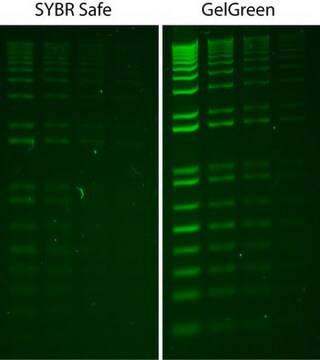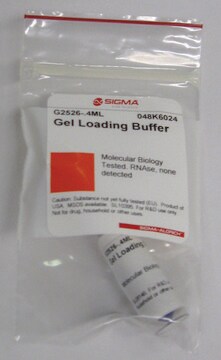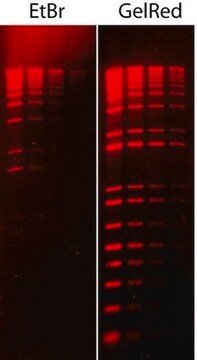S9430
SYBR® Green I nucleic acid gel stain
10,000 × in DMSO
Synonym(s):
DNA stain, SYBR® green gel dye, safer gel stain
About This Item
Recommended Products
form
solution
Quality Level
usage
1.0 mL sufficient for 100 mini-gels
greener alternative product characteristics
Designing Safer Chemicals
Learn more about the Principles of Green Chemistry.
sustainability
Greener Alternative Product
concentration
10,000 × in DMSO
technique(s)
PCR: suitable
greener alternative category
storage temp.
−20°C
Looking for similar products? Visit Product Comparison Guide
Related Categories
General description
Application
- the quantification of dsDNA
- to stain DNA in polymerase chain reaction (PCR)
- for comet assay technique
- to assess spermatozoon membrane integrity
- for visual inspection of DNA amplified by loop-mediated isothermal amplification (LAMP)
- as a fluorescent dye in flow cytometry
- real-time quantitative reverse transcription-polymerase chain reaction (qRT-PCR) for staining reverse-transcribed cDNA
Features and Benefits
- An ultrasensitive stain for post-electrophoresis staining of dsDNA in agarose or polyacrylamide gels
- It can also detect ssDNA and RNA in denaturing agarose/formaldehyde and polyacrylamide/urea gels without any pre-washing steps
- It is less mutagenic than ethidium bromide in Ames tests
- It provides 50-100 times greater detection sensitivity than ethidium bromide for oligonucleotides
- Useful for many applications with a limited amount of DNA
- The binding of SYBR® Green I to DNA does not inhibit the activity of many common restriction endonucleases, including Hind III and EcoR I
- Removal of this stain in-gel digestion and ligation techniques is not needed
- SYBR Green I is a greener alternative product to ethidium bromide for staining
Storage and Stability
Legal Information
related product
Storage Class Code
10 - Combustible liquids
WGK
WGK 3
Flash Point(F)
201.2 °F - closed cup
Flash Point(C)
94 °C - closed cup
Personal Protective Equipment
Choose from one of the most recent versions:
Already Own This Product?
Find documentation for the products that you have recently purchased in the Document Library.
Customers Also Viewed
detection of Tritrichomonas foetus
Articles
Whole transcriptome amplification (WTA) is a method often used to amplify small quantities of reverse transcribed RNA, or degraded RNA for direct use in Next-Generation Sequencing (NGS) workflows. Discover our SeqPlex™-I WTA library preparation kit for producing libraries that are ready for direct input onto Illumina® NGS flow cells.
Protocols
The SeqPlex DNA Amplification Kit for whole genome amplification (WGA) is designed to facilitate next-generation sequencing (NGS) from extremely small quantities or from degraded/highly fragmented DNA
Protocol using hot start dNTPs. Method includes modified nucleoside triphosphates that block DNA polymerase nucleotide incorporation during hot start PCR to increase specificity. Compatible with a variety of PCR reagents.
The SeqPlex RNA Amplification kit provides a method for amplification of total RNA or isolated mRNA prior to entry into the workflows of the commonly used deep sequencing platforms.
Related Content
WTA2, a Whole Transcriptome Amplification (WTA) method, allows for representative amplification of nanogram quantities of total RNA in less than 4 hours without 3-bias
Our team of scientists has experience in all areas of research including Life Science, Material Science, Chemical Synthesis, Chromatography, Analytical and many others.
Contact Technical Service









